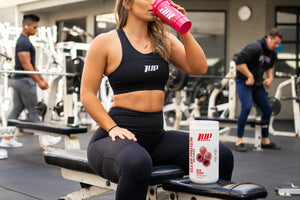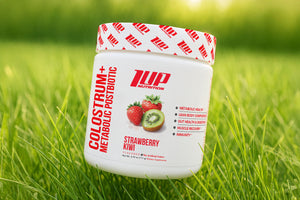Let’s be real.
The main reason a lot of us work out and eat right is to look good.
Unfortunately, it isn’t always easy to see the changes happening from one week to the next.
And, when you don’t see progress happening quickly, you can lose motivation to follow the straight and narrow path of your diet and training program.
This is where tracking your body composition can be handy.
Tracking body composition allows you to see exactly what is happening with your physique from one week to the next.
Now, there are a lot of options available to track your body composition, such as DEXA, BodPod, BIA devices, and more. However, each of these devices suffers from its own set of limitations, including accuracy and precision.
Furthermore, many of these body composition devices are expensive, and for the average person looking to build some muscle and lose some body fat, they’re really not necessary.
That’s where this article comes in.
Here, we’ll show you how to track your body composition in 3 simple steps, and with this knowledge, you’ll be able to tweak your nutrition and training to accommodate your desired performance and physique goals.
Let’s get started.
How to Track Your Body Composition
Weigh Yourself Daily and Calculate Weekly Averages
When it comes to tracking body composition, the first thing we need to start with is tracking your body weight.
Now, most people approach their weigh-ins in one of two ways:
- They do it once every other week, or
- They do it every day
There are problems with each of these scenarios:
The first person who only weighs themselves once in a while really has no idea of their weight fluctuations from week to week. If you weigh yourself after a bad day of eating, the number on the scale could be several pounds higher, leading you to think that you’ve gained a lot of unwanted body fat, when you actually haven’t.
The second person, who weighs themselves daily, might also read too much into a single day’s scale reading and drastically alter their diet or exercise routine based on the number on the scale.
You see, our weight is in flux. It fluctuates from one day to the next and even throughout the day.
This is why the number on the scale shouldn’t be the only metric you use to gauge the success or failure of a diet and exercise program. Furthermore, the number on the scale is just that, a number -- it provides no context of how much of that weight is bone, muscle, fat, or water.
This is why we recommend you weigh yourself daily and calculate a weekly average.
This way, you get an idea of how your weight is changing from week to week, but from a more global perspective.
If your weekly average is consistently going down over the course of several weeks, you can feel fairly certain that you’re losing weight. Conversely, if your weekly average is going up week after week, you know that you’re gaining weight.
To calculate your weekly body weight average:
- Weigh yourself at the same time each day and record the number (ideally, you would do this first thing in the morning after using the bathroom and before consuming and fluids or food)
- Add together your daily body weights from Sunday through Saturday
- Divide the total by 7 (since there are seven days in the week)
That’s all there is to it!
Now, let’s move onto step #2 for how to track your body composition
Take Weekly Progress Pictures
Everyone has a camera these days on their smartphone, tablet, or laptop, which makes the task of taking weekly progress pictures much easier than it used to be when you actually had to have a dedicated snapshot camera.
The reason we recommend taking progress pictures is that it can be difficult to see the slight changes occurring in your physique from one week to the next.
Yet, it’s noticing these subtle changes that can help serve as motivation to keep you constantly plugging away during your transformation challenge.
Plus, at the end of your journey, you’ll have an entire photo album worth of material so you can compare your beginning and final pictures and see just how far you’ve come in a relatively short amount of time.
Similar to recording your daily weight, there are a few pointers we suggest to help ensure consistency:
- Take the picture at the same time each day (ideally, like your weigh-in, it’s first thing in the morning)
- Use the same lighting, background, and camera for every photo
- Take photos from multiple angles (front, side, back) as well as flexed and unflexed.
Take Weekly Body Measurements
The final step for how to track your body composition is to take weekly body measurements.
As we mentioned above, tracking bodyweight alone isn’t enough to tell you how your body composition is improving.
To track your body measurements all you need are two simple, affordable pieces of equipment:
- Body fat calipers
- A measuring tape
Body fat calipers are a set of metal or plastic clamps that measure the thickness of your skin, and they provide an easy and reliable method for tracking your body fat percentage.
Basically, if the measurement is getting thinner, you’re losing fat, and on the flip side, if it’s getting thicker, then you’re gaining fat.
Record the reading from your body fat calipers every week and keep track of how they change.
In addition to a set of body fat calipers, we also recommend a measuring tape to keep track of your waist circumference.
The reason for this is that waist circumference is a simple and reliable indicator of fat loss or gain.
To measure your waist, stand up straight with your abs relaxed -- no sucking in your gut, here folks -- wrap the measuring tape around your waist just above the belly button and pull it tight, but not so tight that you cause the skin to deform.
Write down the measurement and you’re done.
With the data from the scale, body fat calipers and measuring tape as well as your weekly progress photos, you have everything you need to simply, reliably, and affordable track your body composition.
Takeaway
In order to reliably know if you are making progress or not in your transformation challenge, it helps to track your body composition.
There are a great many options available for tracking one’s body comp, but by and large, they’re not necessary or worth the expense. Furthermore, they can also be unreliable.
That’s why we’ve provided this simple 3-step guide for how to track body composition.
With knowledge comes power, and by keeping tabs on your weekly measurements, you’ll know what tweaks need to be made to keep you on track with your body transformation.






